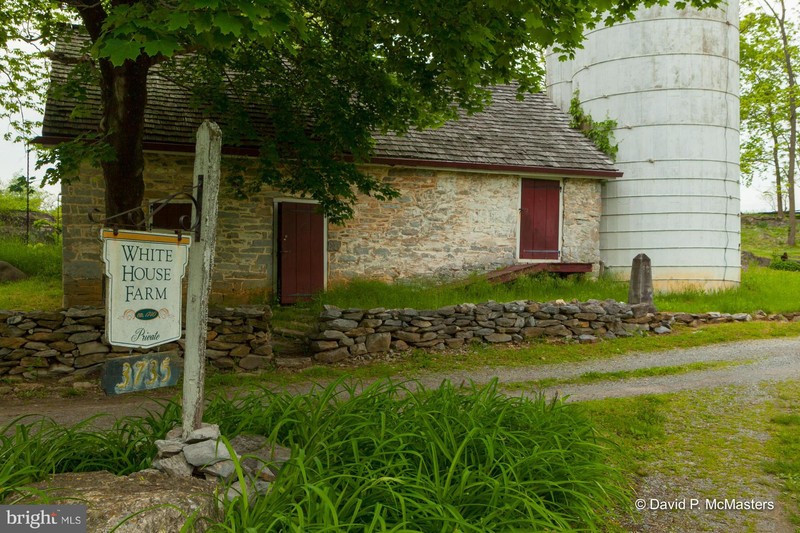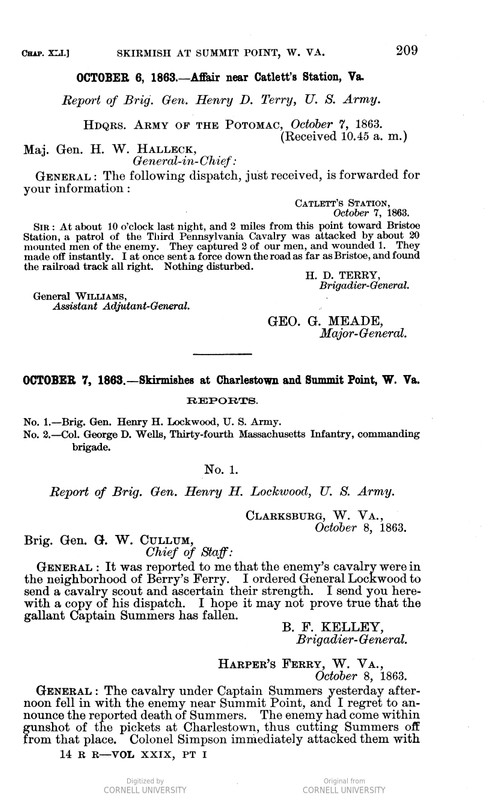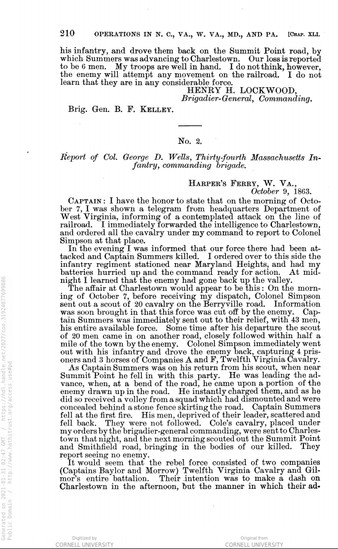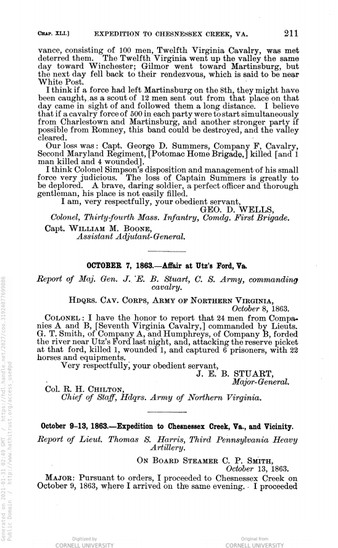UCV Civil War Military Operations Marker #13: Skirmish at White House Farm, October 17, 1863
Introduction
Text-to-speech Audio
Images
View of stone barn with the United Confederate Veterans obelisk erected in 1910.

Colonel Harry Gilmor
.jpg)
Union reports of October 17, 1863 skirmish, page 1

Union reports of October 17, 1863 skirmish, page 2

Union reports of October 17, 1863 skirmish, page 3

Backstory and Context
Text-to-speech Audio
White House was the site of a Civil War cavalry skirmish on October 7, 1863 between Confederate forces under Major Harry Gilmor and Union troops under Captain George D. Summers. Union Colonel George D. Wells at Harpers Ferry received reports of Confederate plans to attack the railroad lines and ordered his cavalry to report to Colonel Simpson at Charles Town. Simpson sent a scouting party of 20 cavalrymen out on the Berryville Road. These Union troops attracted the attention of Major Gilmor’s Confederate cavalry and they pursued the Union riders but was not able to completely cut them off from Charles Town. When Colonel Simpson received reports that his scouts were potentially cut off from Charles Town, he sent a second force of 43 cavalrymen under Captain Summers out to reinforce them. The original scouts ended up returning to Charles Town by a different route, pursued by Gilmor’s men. Simpson sent his infantry out to push Gilmor’s cavalry away, and Gilmor recalled that a few of his men were captured and he turned his men back towards his camp around Summit Point. According to Gilmor’s postwar account he reached White House, owned then by a Mr. Morrow, and let his men dismount, rest the horses, and get water from the spring. While he was talking to the family, Captain Summers and his cavalry approached.
The Union and Confederate accounts of the skirmish differ. According to the Union report after the battle, Summers was at the head of his force on the road, and coming around the bend encountered Confederate forces stationed across the road. Summers charged them and fell in the first volley of fire. After Summers fell, the report states, the Union forces scattered and fell back and were not pursued. In Gilmor’s account, his men were dismounted and resting, not in formation in the road and while Summers wanted to charge his men were hesitant to move forward. Gilmor recorded Summers’ death as such: “At that moment Captain Somers, who I must say was a brave man, spurred his horse down the hill, and engaged me with his pistol, firing wildly, for I saw he was much excited. I reserved my fire till he came within twenty paces, steadied my horse with the bit, took a long, sure aim, and Somers fell from his horse. The ball entered the side of his nose, and came out at the back of his head.” According to the Union report, Summers’ men were not pursued in their retreat; however, in Gilmor’s recollection his men did pursue the fleeing Federals, stating that he had to jump his horse over the body of Summers lying in the road. Gilmor described close fighting with the Union cavalrymen, charging and taking prisoners, and forcing the Union troops to run. The Union report was written the day following the skirmish and Gilmor’s account was a memoir published in 1866, which may account for some of the differences in the accounts. On the White House property is a small stone obelisk, placed in 1910 by the Jefferson County Camp of United Confederate Veterans. This obelisk is number thirteen in a series of monuments through Jefferson County. There is a second #13 obelisk placed in Summit Point later; apparently it was intended to replace this older monument, but the original still stands.
About the Monuments:
This series of monuments and accompanying tour pamphlet were part of an initiative from the Jefferson County Camp, United Confederate Veterans to commemorate the 50th anniversary of the Civil War. In 1910 Col. R. Preston Chew and the Jefferson County UCV raised the funds to place 25 concrete obelisks in Jefferson County to mark locations of engagement or other significant events. The following year the Camp published a pamphlet to accompany the obelisks and give more information about each location. This was Military Operations in Jefferson County, Virginia (Now West Virginia), 1861-1865 published in 1911. The pamphlet has been reprinted several times by the Henry Kyd Douglas Camp, No. 199 of the Sons of Confederate Veterans. Because the monuments and accompanying pamphlet were done by Confederate veterans it is likely that the locations and descriptions are biased towards or favor the Confederate view and experience of the war.
Original Text from the 1911 Pamphlet:
"Marker Number Thirteen
An Account by Col. Harry Gilmor of His Fight with Somers Near Summit Point
About the close of September, 1863, I took 50 men from my camp at Mt. Jackson with the intention of crossing the Potomac to capture a lot of government horses and mules which my scouts had reported to be grazing in the neighborhood of Hagerstown. Their picket lines extended to and beyond Charles Town, where a regiment of infantry and two companies of cavalry were stationed. Captain Somers commanded the cavalry, and Col. Benjamin Simpson the 9th Maryland. I crossed the line without being detected, but when I reached the river I found it past fording, and had to return.
I camped in the woods on William Washington’s place, and, being determined not to go back without some game, sent scouts to watch the road leading out of Charles Town. I had not slept more than two hours when I learned that 25 cavalry had gone up the road leading to Smithfield. The men were soon mounted, and, striking out across the country, we got into the road in the rear of this squad, and followed on their trail to Smithfield. Soon after reaching the turnpike we met a man whom I knew to be a Unionist, but, expecting to capture the party ahead of me before they could reach Charles Town in my rear, I let him pass. What a change it would have made in subsequent events had I taken him along with us! We continued at a trot until we gained the hill immediately above Smithfield, when I closed up the column, drawing sabres, charged into the town, expecting to find the enemy there; but to my chagrin, learned that they had passed through without halting, taking the road to Summit Point, and were now a considerable distance ahead. I followed on at a good swinging trot, with four or five well mounted men in advance, until we got nearly to Summit Point, when my scouts returned, saying the enemy had passed through that place also a short time previous, and were now on the road back to Charles Town.
My horses were by this time much jaded, and some hardly able to keep up; still, determined not to abandon the enterprise, I struck across the fields, hoping to cut them off before they could reach Charles Town. In this I did not succeed; but three of my men ran into their rear guard just as they were entering the place. One of them, Charles Forman, was captured. I dismounted half my men, put them in position, and tried to draw out the enemy, but they had their own plan in view, and refused to follow. This made me rather suspicious, so putting twelve men under Captain Blackford as a rear guard, I started for Summit Point and camp.
I had reached the “White House, owned by Mr. Morrow, two miles from Summit Point, had halted to let the men dismount and get water from the large spring about fifty yards off, and was the only mounted man left in the road. I had ridden up to the yard fence, and was talking to the ladies, when I heard a voice exclaim, “Here they are boys by God, we’ve got them now?” At the same instant a bullet whistled through a lilac bush between the ladies and myself. I wheeled around and saw the head of a cavalry column on the rocky hill above, and between me and Summit Point.
Here was a perilous position. Seeing only the first section of fours, I knew not how many were behind them. I could not retreat, and therefore determined to make the best fight possible under the circumstances. I ordered ten of my men who had carbines to get behind the ruins of an old stone stable, and fight them to the last. Seeing my horses without their riders, the others thought we were apprized of their coming, and had prepared an ambuscade; and though Captain Somers, whom I recognized, begged, implored, and cursed them, they would not charge, but stood still on the hill, popping away at us with their carbines.
One of my men—Ford, from Baltimore—came up with a rifle and putting his hand on my thigh, asked what he should do. I told him to get behind the stone wall, and take a good aim every time he fired. “all right, Major.” Just as he spoke the word a ball pierced his head, killing him instantly.
At that moment Captain Somers, who I must say was a brave man, spurred his horse down the hill, and engaged me with his pistol, firing wildly, for I saw he was much excited. I reserved my fire till he came within twenty paces, steadied my horse with the bit, took a long sure aim, and Somers fell from his horse. The ball entered the side of his nose, and came out the back of his head.
By this time nine of my men had mounted, and, as the sharpooters (sic) had been doing good work, I thought I could risk a charge, but it was unnecessary to give the order, for I heard Read or Bosley say, “come, boys it’s a shame to leave the major there by himself;” and by the time I had returned the pistol and drawn my sabre, the boys were at my side, so on we went.
When we gained the hill top, I saw, to my amazement, that there were about sixty before me, but, as there was a good post and rail fence on either side, they could show no more front than my ten men. To whip the foremost was to whip all. As I passed by the stone stable I ordered the rest to mount and follow. Captain Somers was lying across the road. I was obliged to jump my horse over his dead body; four others lying near were either dead or wounded.
Settling myself in the saddle, I dashed in among the blue jackets, cutting and thrusting right and left, and parrying a blow when necessary. They were from Michigan and Maryland, and for a while fought well. Observing an officer fighting like a Turk and cheering his men on, I made for him. He was a man of my own size, wore a very heavy beard, and looked, I thought very savage as he yelled out, “come on you damned rebel, I’ll soon fix your flint.” This promised good sport. I closed with him, making a powerful front cut, which he parried, and at the same instant made a right cut at my neck. By bringing my sabre down in time, my side caught the blow. Now I had the advantage. Quick as a flash I cut him across the check, inflicting a large gash, and he fell to the ground. I gave him in charge of one of my men, and then followed after my first ten, who had pushed the column back two hundred yards while the lieutenant and I were busy with our affair. The latter soon after escaped by jumping a stone wall and running into a thick woods. We soon got them on the run, nor did we give them time to stop and reform until they had passed through and beyond Summit Point.
We had taken eighteen prisoners, and were unable to pursue them farther until my men had come up, for the federals had formed and turned upon the two or three men who were still in pursuit, but by the time they had pushed these back again to Summit Point I had dismounted ten or fifteen men, who easily checked them. We charged again, took five more prisoners, and the rest made their escape.
After collecting my prisoners and men, I left by a private route for the Upper Valley, with twenty three prisoners and twenty nine horses, leaving four of their dead and three wounded on the field. My loss was one man killed, three wounded, and one taken prisoner. I reached camp safely with everything I had captured.
It seems the Unionist went immediately to Charles Town and gave information of what he had seen, and Somers followed me all the way round. A sad affair it turned out for him, but “such are the fortunes of war”. Captain Somers was highly esteemed by his commanding officers, as shown by a long article, highly complimentaoy (sic) to him, that appeared a few days after. The same paper also alleged that I had murdered him! Indeed! Then not a few were murdered on both sides."
Cite This Entry
Historic Landmarks Commission, Jefferson County and Kathleen Thompson. "UCV Civil War Military Operations Marker #13: Skirmish at White House Farm, October 17, 1863." Clio: Your Guide to History. February 17, 2021. Accessed March 24, 2025. https://theclio.com/tour/1805/13/reverse
Sources
Bushong, Millard Kessler. A History of Jefferson County, West Virginia. Charles Town, WV: Jefferson Publishing Company, 1941.
Engle, Stephen Douglas. Thunder in the Hills: Military Operations in Jefferson County, West Virginia, During the American Civil War. Charleston, WV: Mountain State Press, 1989.
Gilmor, Harry, Colonel. Four Years in the Saddle. London: Longmans, Green, and Co., 1866. https://www.google.com/books/edition/Four_Years_in_the_Saddle/N7VXAAAAcAAJ?hl=en&gbpv=1.
Military Operations in Jefferson County Virginia (and West Va.) 1861-1865. Published by Authority of Jefferson County Camp U.C.V. Farmers Advocate Print, 1911. Accessed January 20, 2021. https://babel.hathitrust.org/cgi/pt?id=uc2.ark:/13960/t4vh5gp6c&view=1up&seq=5.
“Report of Col. George D. Wells, Thirty-fourth Massachusetts Infantry, commanding brigade. Harpers Ferry, W. Va. October 9, 1863.” Page 210-211. The Miscellaneous Documents of the House of Representatives for the First Session of the Fifty-First Congress, 1889-’90. In Forty-Seven Volumes. Government Printing Office: Washington, 1891. https://books.google.com/books?id=L7wZAAAAYAAJ&pg=PA209&lpg=PA209&dq=summit+point+october+7,+1863+skirmish&source=bl&ots=02kpFIcqNK&sig=ACfU3U1bKm_dSRQYB33mY6AQMRxEU1mzlA&hl=en&sa=X&ved=2ahUKEwjAoPnz28DtAhXos1kKHQ5pCws4ChDoATAJegQIChAC#v=onepage&q&f=false.
"3735 Summit Point Rd, Charles Town, WV 25414." Snyder Bailey. Accessed January 30, 2021. https://snyderbailey.com/IDX/3735-SUMMIT-POINT-RD-Charles-Town-WV-25414/121142075356_MRIS/0005604.
"Harry Gilmor." Wikipedia. Accessed January 30, 2021. https://en.wikipedia.org/wiki/Harry_Gilmor.
The War of the Rebellion: a Compilation of the Official Records of the Union and Confederate Armies. Series.1:vol.29:pt.1:Reports. p. 209. Accessed January 30, 2021. https://babel.hathitrust.org/cgi/pt?id=coo.31924077699886&view=1up&seq=3.
The War of the Rebellion: a Compilation of the Official Records of the Union and Confederate Armies. Series.1:vol.29:pt.1:Reports. p. 210. Accessed January 30, 2021. https://babel.hathitrust.org/cgi/pt?id=coo.31924077699886&view=1up&seq=3.
The War of the Rebellion: a Compilation of the Official Records of the Union and Confederate Armies. Series.1:vol.29:pt.1:Reports. p. 211. Accessed January 30, 2021. https://babel.hathitrust.org/cgi/pt?id=coo.31924077699886&view=1up&seq=3.

